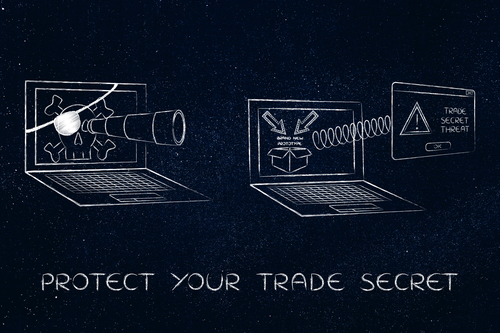 When many people think of trade secrets, they envision something mysterious and legendary—such as the original Coca-Cola formula locked in an Atlanta vault, or Col. Sanders’ recipe for fried chicken. But many companies have proprietary information that is important to their business and that isn’t readily available to the public. For example, lists of customers, manufacturing methodologies and in-house business practices can be trade secrets.
When many people think of trade secrets, they envision something mysterious and legendary—such as the original Coca-Cola formula locked in an Atlanta vault, or Col. Sanders’ recipe for fried chicken. But many companies have proprietary information that is important to their business and that isn’t readily available to the public. For example, lists of customers, manufacturing methodologies and in-house business practices can be trade secrets.
There are legal avenues available for trade secret holders to protect their intellectual property. Currently, 48 states and a number of U.S. territories have adopted the Uniform Trade Secrets Act (USTA). The USTA defines a trade secret as “information, including a formula, pattern, compilation, program, device, method, technique, or process, that:
(i) derives independent economic value, actual or potential, from not being generally known to, and not being readily ascertainable by proper means by, other persons who can obtain economic value from its disclosure or use, and
(ii) is the subject of efforts that are reasonable under the circumstances to maintain its secrecy.”
It is important to note that unlike many other forms of intellectual property, there is no expiration date on trade secrets. Additionally, trade secrets are not registered with any administrative body within the government and no fees are due to the government to maintain rights to trade secrets. A trade secret holder retains the rights as long as he or she properly maintains the secret so that it is not made publicly known. Multiple parties may share the same trade secret, but a trade secret ceases to exist when it becomes common knowledge. Therefore, if another party that independently derived a trade secret makes such information public, the owner of the trade secret no longer holds an enforceable right.
Trade secret holders must take reasonable precautions to maintain the secrecy of their secrets, such as keeping such information on a “need-to-know” basis. Companies should have clear IP, confidentiality, and employment agreements describing which types of information are considered trade secrets. These agreements should also describe an employee’s responsibility for maintaining the secrecy of such information. In spite of reasonable precautions by a trade secret holder, bad actors may maliciously misappropriate trade secrets.
However, flagrant industrial espionage is off-limits, and trade secret holders are not penalized for not maintaining secrets under the USTA if they are hit by such an attack. In order to ensure reasonable precautions are taken in order to secure trade secret protection, consider consulting an attorney regarding appropriate employment agreements.
In addition to the USTA, the Defend Trade Secrets Act (DTSA) was enacted as federal law in May of 2016. The DTSA includes similar provisions to those in the USTA and is enforceable for acts of trade secret misappropriation occurring after enactment. The DTSA does not preempt the state law in each state, but rather provides trade secret owners with an option whether to pursue claims for misappropriation in federal or state courts.
Misappropriate and Remedies
The USTA and DTSA provide remedies for IP holders whose trade secrets are taken without their will or through improper means. These remedies include injunctive relief barring the other party from using misappropriated trade secrets, damages (both real and punitive), and even attorney’s fees in some cases.
Such liability exists if someone:
- Discovers a trade secret through improper means (i.e. stealing documents, hacking into a competitor’s system, etc.) This includes discovering trade secrets from a third-party who obtained that information improperly.
- Breaks a confidence placed in him or her by the trade secret holder.
- Learns a trade secret by mistake, knowing that the information was intended to be secret.
But not every trade secret discovery is an illegal one. For example, reverse engineering a trade secret or otherwise discovering a trade secret through legal means is not a misappropriation under the law.
Likewise, if you don’t take steps to protect your information, it is fair game if a competitor learns it. Having employees sign confidentiality agreements, and regularly reminding them of the importance of protecting confidential information, are solid, basic steps to protecting trade secrets.
In some cases, trade secrets may also be eligible for patent protection. As discussed elsewhere herein, patent protection may provide different and additional rights compared to trade secret protection. However, obtaining a patent on a technology may require disclosure of one or more related trade secrets. Therefore, consider consulting with an attorney regarding whether to pursue a patent for a particular technology or hold the technology as a trade secret.
Trade secrets are an important, although sometimes forgotten, part of a company’s IP toolkit. But as with any piece of intellectual property, trade secrets need to be proactively protected in order to ensure the holder reams the most possible benefit from them.
This is the fourth and final installment of Womble Bond Dickinson’s Intellectual Property Considerations and Guidance for Start-Ups series. Click the links to read previous chapters on Patents, Trademarks and Copyrights at IPWatchdog.
Image Source: Deposit Photos

![[IPWatchdog Logo]](https://ipwatchdog.com/wp-content/themes/IPWatchdog%20-%202023/assets/images/temp/logo-small@2x.png)




![[Advertisement]](https://ipwatchdog.com/wp-content/uploads/2024/04/UnitedLex-May-2-2024-sidebar-700x500-1.jpg)
![[Advertisement]](https://ipwatchdog.com/wp-content/uploads/2024/04/Artificial-Intelligence-2024-REPLAY-sidebar-700x500-corrected.jpg)
![[Advertisement]](https://ipwatchdog.com/wp-content/uploads/2024/04/Patent-Litigation-Masters-2024-sidebar-700x500-1.jpg)

![[Advertisement]](https://ipwatchdog.com/wp-content/uploads/2021/12/WEBINAR-336-x-280-px.png)
![[Advertisement]](https://ipwatchdog.com/wp-content/uploads/2021/12/2021-Patent-Practice-on-Demand-recorded-Feb-2021-336-x-280.jpg)
![[Advertisement]](https://ipwatchdog.com/wp-content/uploads/2021/12/Ad-4-The-Invent-Patent-System™.png)






Join the Discussion
One comment so far.
Autrige Dennis
November 5, 2018 11:46 amGreat article. As a Patent Illustrator I’ve always believed in protecting the trade secrets for my drawing technique and my methods of marketing. Patent illustration techniques is not something taught in school, it’s takes years of development and the technique varies between illustrators. Throughout the years I’ve developed a system for creating high quality and accurate drawings. My dealings with every conceivable form of drawing has been the key. IP Attorneys, inventors and even fellow patent illustration companies are drawn to my service and are a part of my process and trade secret development. My clients benefit because my trade secrets results in lower price for their drawings. Many times I see patent illustration or design companies or other unrelated companies fishing for my marketing or drawing techniques. That’s why I don’t write many blogs about patent drawings how-tos because all I will be doing is disclosing my trade secrets. Instead I focus on educating inventors or directing them to qualified IP attorneys.